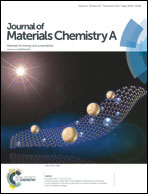Dye sensitized solar cells with cobalt and iodine-based electrolyte: the role of thiocyanate-free ruthenium sensitizers†
Abstract
Three isomeric Ru(II) metal complexes with distinctively oriented tpiq ancillary chelates, TFRS-80a, 80b and 80c, were prepared from the condensation of Ru(4,4′-diethoxycarbonyl-2,2′-bipyridine) (p-cymene)Cl with tpiqH, i.e. 6-(5-(2,6-bis(hexyloxy)phenyl)thiophen-2-yl)-1-(3-(trifluoromethyl)-1H-pyrazol-5-yl)isoquinoline. Photophysical and electrochemical investigations, together with DFT and TD-DFT calculations, allowed a comprehensive understanding of their basic properties in both solution state and on TiO2 surface. DSC cells with both an ultra-thin layer of transparent TiO2 (3.6 μm) and I−/I3− electrolyte were fabricated, for which the symmetric sensitizers TFRS-80a and 80c showed better performances (η = 8.37 and 8.26%) over that of the asymmetric counterpart TFRS-80b (η = 5.55%), the latter suffered from poor dye loading and consequently lowered JSC and VOC. In sharp contrast, all DSC cells with [Co(phen)3]2+/3+ electrolyte gave superior efficiencies (η = 8.36–9.06%), for which the thiocyanate-free architecture, the improved light harvesting capability, and the possession of conjugated and bulky 5-(2,6-bis(hexyloxy)phenyl)thiophen-2-yl functional moieties are three primary factors governing the observed results.


 Please wait while we load your content...
Please wait while we load your content...